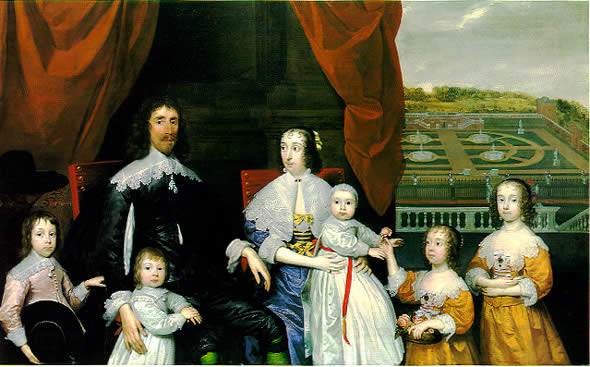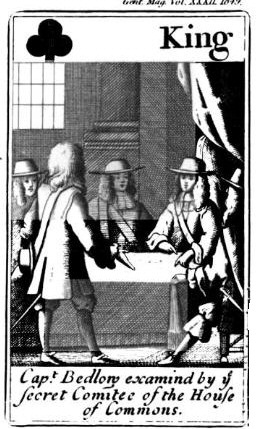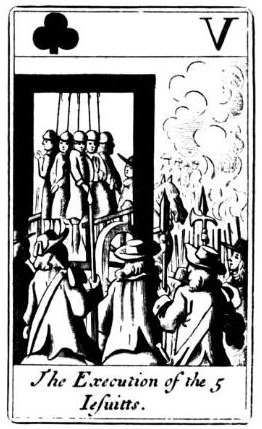|
Mary Somerset, Duchess Of Beaufort (1630-1715)
Mary Somerset, Duchess of Beaufort (baptised 16 December 1630 – 7 January 1715) also known by her other married name of Mary Seymour, Lady Beauchamp and her maiden name Mary Capell, was an English noblewoman, gardener and botanist. Among her introductions to British gardening are ''Pelargonium zonale'', ''Ageratum'' species and ''Passiflora caerulea''. Early life Mary was born in Hadham Parva, Hertfordshire, sometime before 16 December 1630, on which date she was baptised. She was the daughter of Sir Arthur Capell, 1st Baron Capell of Hadham and Elizabeth Morrison. Life On 28 June 1648, Mary married her first husband Henry Seymour, Lord Beauchamp, and they had one son and one daughter. Her husband was a Royalist, imprisoned during the English Civil War. Her second husband, whom she married on 17 August 1657 was Henry Somerset, who became 1st Duke of Beaufort, by whom she had six children. During the Popish Plot, she was required in her husband's absence to call out the ... [...More Info...] [...Related Items...] OR: [Wikipedia] [Google] [Baidu] |
Her Grace
His Grace or Her Grace is an English style used for various high-ranking personages. It was the style used to address English monarchs until Henry VIII and the Scottish monarchs up to the Act of Union of 1707, which united the Kingdom of Scotland and the Kingdom of England. Today, the style is used when referring to archbishops and non-royal dukes and duchesses in the United Kingdom. Examples of usage include His Grace The Duke of Norfolk; His Grace The Lord Archbishop of Canterbury; or "Your Grace" in spoken or written address. As a style of British dukes it is an abbreviation of the full formal style "The Most High, Noble and Potent Prince His Grace". Royal dukes, for example Prince Edward, Duke of Kent, are addressed with their higher royal style, Royal Highness. The Duchess of Windsor was styled "Your Grace" and not Royal Highness upon marriage to Prince Edward, Duke of Windsor. Ecclesiastical usage Christianity The style "His Grace" and "Your Grace" is used in England ... [...More Info...] [...Related Items...] OR: [Wikipedia] [Google] [Baidu] |
Passiflora Caerulea
''Passiflora caerulea'', the blue passionflower, bluecrown passionflower or common passion flower, is a species of flowering plant native to South America. It has been introduced elsewhere. It is a vigorous, deciduous or semi-evergreen tendril vine growing to or more. Its leaves are palmate, and its fragrant flowers are blue-white with a prominent fringe of coronal filaments in bands of blue, white,yellow, and brown. The ovoid orange fruit, growing to , is edible, but is variously described as having a bland, undesirable, or insipid taste. In South America, the plant is known for its medicinal properties, and is used by both the Toba and the Maka peoples. Names The specific epithet ''caerulea'' means "blue" and refers to the blue coronal filaments. Description ''Passiflora caerulea'' is a woody vine capable of growing to high where supporting trees are available. The leaves are alternate, palmately five-lobed (sometimes three, seven, or nine lobes), and are up to in length wh ... [...More Info...] [...Related Items...] OR: [Wikipedia] [Google] [Baidu] |
William Aiton
William Aiton (17312 February 1793) was a Scotland, Scottish botanist. Aiton was born near Hamilton, Scotland, Hamilton. Having been regularly trained to the profession of a gardener, he travelled to London in 1754, and became assistant to Philip Miller, then superintendent of the Chelsea Physic Garden. In 1759 he was appointed director of the newly established Royal Botanic Gardens, Kew, botanical garden at Kew, where he remained until his death. He effected many improvements at the gardens, and in 1789 he published ''Hortus Kewensis'', a catalogue of the plants cultivated there. He is buried at nearby St. Anne's Church, Kew. A second and enlarged edition of the ''Hortus'' was brought out in 1810–1813 by his eldest son, William Townsend Aiton. Aiton is commemorated in the Specific epithet (botany), specific epithet ''aitonis''. In 1789, he classified the Sampaguita plant to the ''Jasmine, Jasminium'' genus and also named it as ''Arabian Jasmine'' because it was believed th ... [...More Info...] [...Related Items...] OR: [Wikipedia] [Google] [Baidu] |
Alice Margaret Coats
Alice Margaret Coats (15 June 1905 – 19 May 1978, in Bath) was a British watercolor painter, engraver, woodcut artist, and author. She was a member of the Central Club of Wood-Engravers in Colour. She is best known for botanical and horticultural works. Life Alice Margaret Coats was born on 15 June 1905 in Handsworth, Birmingham to a Scottish clergyman, the Rev. Robert Hay Coats, and his wife Margaret, who was from Glasgow. Coats was educated at Edgbaston High School before studying at the Birmingham Central School of Art between 1922 and 1928, at the Slade School of Fine Art in London and in Paris during the 1930s at Andre Lhote's school. Coats produced book illustrations, flower paintings on silk, colour woodcuts, and landscape paintings in both oil and watercolours. Between 1933 and 1939 Coats was an organizing secretary of the ‘Birmingham Group’ of artists and during World War II from 1940 to 1945 served in the Land Army helping to cultivate land on which Birmingh ... [...More Info...] [...Related Items...] OR: [Wikipedia] [Google] [Baidu] |
William Scroggs
Sir William Scroggs (c. 162325 October 1683) was Lord Chief Justice of England from 1678 to 1681. He is best remembered for presiding over the Popish Plot trials, where he was accused of showing bias against the accused. Youth and early career Scroggs was the son of an Oxford landowner; the story of him being the son of a butcher of sufficient means to give his son a university education is merely a rumour, although one which was widely believed. He spent his youth in Stifford. He went to Oriel College, and later to Pembroke College, Oxford, where he graduated in 1640, having acquired a fair knowledge of the classics. There is some evidence that he fought on the royalist side during the Civil War; certainly, his loyalty to the Crown was never doubted in later years. In 1653 he was called to the bar, and soon gained a good practice in the courts. He was appointed a judge of the Common Pleas in 1676. Two years later he was promoted to the office of Lord Chief Justice on the recomme ... [...More Info...] [...Related Items...] OR: [Wikipedia] [Google] [Baidu] |
Richard Langhorne
Richard Langhorne (c. 1624 – 14 July 1679) was an English barrister and Catholic Christian martyr, martyr, who was executed on a false charge of treason as part of the fabricated Popish Plot. He fell under suspicion because he was a Roman Catholic and because he had acted as legal adviser to the Jesuits at a time of acute anti-Catholic hysteria. Background and early life He was the third son of William Langhorne, a barrister, and his wife Lettice Needham, of Little Wymondley in Hertfordshire. He was admitted to the Inner Temple in May 1647 and called to the bar in November 1654. He was a Roman Catholic, and provided legal and financial advice for the Jesuits. During the wave of anti-Catholic hysteria which followed the Great Fire of London of 1666, he was briefly arrested but quickly released. His wife, Dorothy Legatt, was a Protestant from Havering in Essex. His sons Charles and Francis were both priests. When, in October 1677, Titus Oates was expelled from the College of St. O ... [...More Info...] [...Related Items...] OR: [Wikipedia] [Google] [Baidu] |
William Bedloe
William Bedloe (20 April 165020 August 1680) was an English fraudster and Popish Plot informer. Life He was born at Chepstow in Monmouthshire. He was probably the son of Isaac Bedloe, himself the son of an Irish Army officer, and a cousin of William Kemys (or Kemish), who became High Sheriff of Monmouthshire in 1678. He appears to have been well educated; he was certainly clever, and after moving to London in 1670 he became acquainted with some Jesuits and was occasionally employed by them. Calling himself now Captain Williams, now Lord Gerard or Lord Newport or Lord Cornwallis, he travelled from one part of Europe to another, usually accompanied by his brother James. In the 1670s he was imprisoned for fraud and became an expert in a number of criminal enterprises. The historian John Kenyon described him as "an experienced member of a London underworld of crime and vice of which we know almost nothing". Then in 1678, following the lead of Titus Oates, he gave an account of a sup ... [...More Info...] [...Related Items...] OR: [Wikipedia] [Google] [Baidu] |
Isle Of Purbeck
The Isle of Purbeck is a peninsula in Dorset, England. It is bordered by water on three sides: the English Channel to the south and east, where steep cliffs fall to the sea; and by the marshy lands of the River Frome and Poole Harbour to the north. Its western boundary is less well defined, with some medieval sources placing it at Flower's Barrow above Worbarrow Bay. John Hutchins, author of ''The History and Antiquities of the County of Dorset'', defined Purbeck's western boundary as the Luckford Lake steam, which runs south from the Frome. According to writer and broadcaster Ralph Wightman, Purbeck "is only an island if you accept the barren heaths between Arish Mell and Wareham as cutting off this corner of Dorset as effectively as the sea." The most southerly point is St Alban's Head (archaically St. Aldhelm's Head). From 1974 to 2019, the whole of the Isle of Purbeck lay within the local government district of Purbeck, which was named after it. The district extended ... [...More Info...] [...Related Items...] OR: [Wikipedia] [Google] [Baidu] |
Militia
A militia () is generally an army or some other fighting organization of non-professional soldiers, citizens of a country, or subjects of a state, who may perform military service during a time of need, as opposed to a professional force of regular, full-time military personnel; or, historically, to members of a warrior-nobility class (e.g. knights or samurai). Generally unable to hold ground against regular forces, militias commonly support regular troops by skirmishing, holding fortifications, or conducting irregular warfare, instead of undertaking offensive campaigns by themselves. Local civilian laws often limit militias to serve only in their home region, and to serve only for a limited time; this further reduces their use in long military campaigns. Beginning in the late 20th century, some militias (in particular officially recognized and sanctioned militias of a government) act as professional forces, while still being "part-time" or "on-call" organizations. For instan ... [...More Info...] [...Related Items...] OR: [Wikipedia] [Google] [Baidu] |
Popish Plot
The Popish Plot was a fictitious conspiracy invented by Titus Oates that between 1678 and 1681 gripped the Kingdoms of England and Scotland in anti-Catholic hysteria. Oates alleged that there was an extensive Catholic conspiracy to assassinate Charles II, accusations that led to the executions of at least 22 men and precipitated the Exclusion Bill Crisis. Eventually, Oates's intricate web of accusations fell apart, leading to his arrest and conviction for perjury. Background Development of English anti-Catholicism The fictitious Popish Plot must be understood against the background of the English Reformation and the subsequent development of a strong anti-Catholic sentiment among the mostly Protestant population of England. The English Reformation began in 1533, when King Henry VIII (1509–1547) sought an annulment of his marriage to Catherine of Aragon to marry Anne Boleyn. As the Pope would not grant this, Henry broke away from Rome and took control of the Church in ... [...More Info...] [...Related Items...] OR: [Wikipedia] [Google] [Baidu] |
English Civil War
The English Civil War (1642–1651) was a series of civil wars and political machinations between Parliamentarians (" Roundheads") and Royalists led by Charles I ("Cavaliers"), mainly over the manner of England's governance and issues of religious freedom. It was part of the wider Wars of the Three Kingdoms. The first (1642–1646) and second (1648–1649) wars pitted the supporters of King Charles I against the supporters of the Long Parliament, while the third (1649–1651) saw fighting between supporters of King Charles II and supporters of the Rump Parliament. The wars also involved the Scottish Covenanters and Irish Confederates. The war ended with Parliamentarian victory at the Battle of Worcester on 3 September 1651. Unlike other civil wars in England, which were mainly fought over who should rule, these conflicts were also concerned with how the three Kingdoms of England, Scotland and Ireland should be governed. The outcome was threefold: the trial of and ... [...More Info...] [...Related Items...] OR: [Wikipedia] [Google] [Baidu] |
Cavalier
The term Cavalier () was first used by Roundheads as a term of abuse for the wealthier royalist supporters of King Charles I and his son Charles II of England during the English Civil War, the Interregnum, and the Restoration (1642 – ). It was later adopted by the Royalists themselves. Although it referred originally to political and social attitudes and behaviour, of which clothing was a very small part, it has subsequently become strongly identified with the fashionable clothing of the court at the time. Prince Rupert, commander of much of Charles I's cavalry, is often considered to be an archetypal Cavalier. Etymology Cavalier derives from the same Latin root as the Italian word and the French word (as well as the Spanish word ), the Vulgar Latin word '' caballarius'', meaning 'horseman'. Shakespeare used the word ''cavaleros'' to describe an overbearing swashbuckler or swaggering gallant in Henry IV, Part 2 (c. 1596–1599), in which Robert Shallow says "I'll drink ... [...More Info...] [...Related Items...] OR: [Wikipedia] [Google] [Baidu] |

.jpg)







